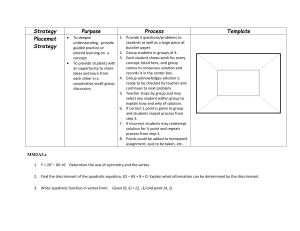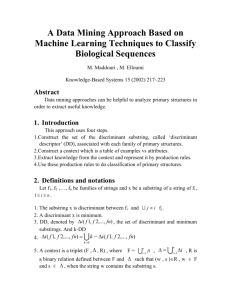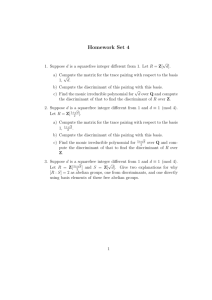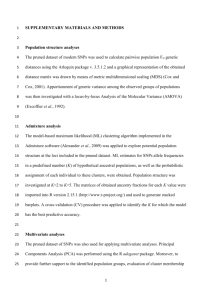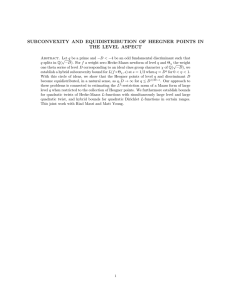Beitr¨ age zur Algebra und Geometrie Contributions to Algebra and Geometry
advertisement
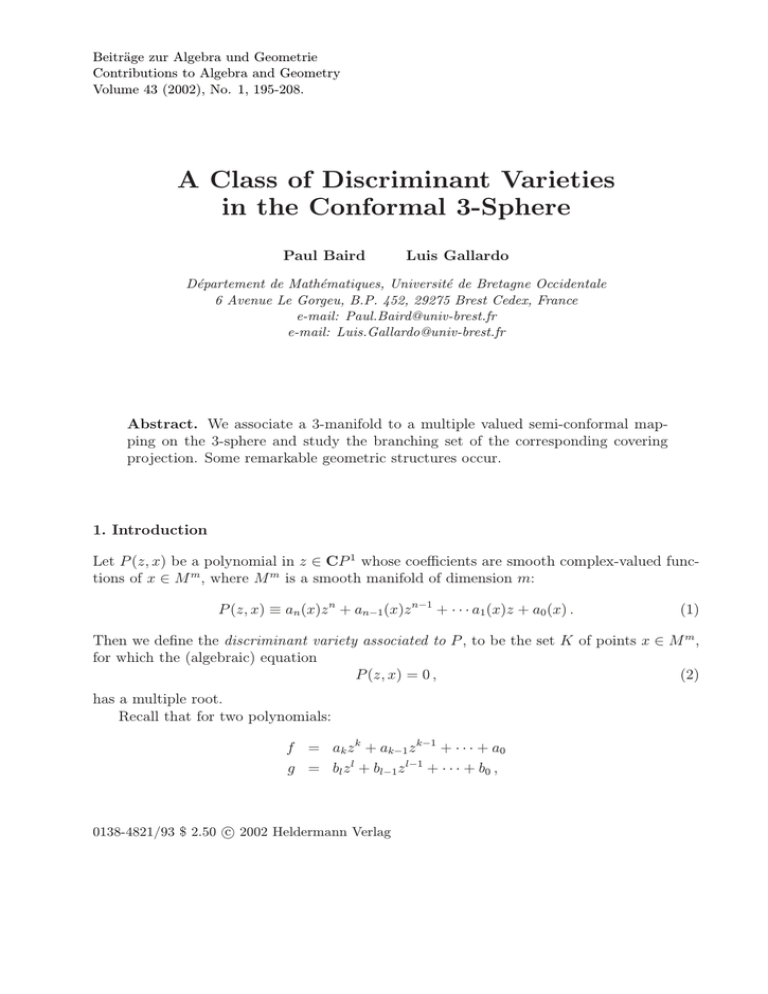
Beiträge zur Algebra und Geometrie
Contributions to Algebra and Geometry
Volume 43 (2002), No. 1, 195-208.
A Class of Discriminant Varieties
in the Conformal 3-Sphere
Paul Baird
Luis Gallardo
Département de Mathématiques, Université de Bretagne Occidentale
6 Avenue Le Gorgeu, B.P. 452, 29275 Brest Cedex, France
e-mail: Paul.Baird@univ-brest.fr
e-mail: Luis.Gallardo@univ-brest.fr
Abstract. We associate a 3-manifold to a multiple valued semi-conformal mapping on the 3-sphere and study the branching set of the corresponding covering
projection. Some remarkable geometric structures occur.
1. Introduction
Let P (z, x) be a polynomial in z ∈ CP 1 whose coefficients are smooth complex-valued functions of x ∈ M m , where M m is a smooth manifold of dimension m:
P (z, x) ≡ an (x)z n + an−1 (x)z n−1 + · · · a1 (x)z + a0 (x) .
(1)
Then we define the discriminant variety associated to P , to be the set K of points x ∈ M m ,
for which the (algebraic) equation
P (z, x) = 0 ,
(2)
has a multiple root.
Recall that for two polynomials:
f = ak z k + ak−1 z k−1 + · · · + a0
g = bl z l + bl−1 z l−1 + · · · + b0 ,
c 2002 Heldermann Verlag
0138-4821/93 $ 2.50 196
P. Baird, L. Gallardo: A Class of Discriminant Varieties . . .
the resultant is the determinant
Rf,g
a
k
= bl
ak−1 · · ·
···
ak
ak−1 · · ·
..
.
bl−1
bl
ak
···
bl−1
ak−1
···
···
..
.
bl
bl−1
· · · · · · a0 b0
· · · b0
· · · · · · b0 a0
· · · a0
As is well-known in algebra, f and g have a common zero if and only if Rf,g = 0, so that the
discriminant variety consists of those points x ∈ M m for which the resultant RP,∂P/∂z (i.e.
the discriminant) vanishes. In general it can be extremely hard to calculate the zero set of
RP,∂P/∂z . One of our objectives is to find other practical ways of doing this. We are able to
achieve this goal for certain classes of polynomials P .
The study of discriminant varieties is motivated by the following covering construction,
well-known in Riemann surface theory and important in 3-manifold theory (see the Introduction of [7] for an account of related constructions).
f = {(z, x) ∈ CP 1 × M m : P (z, x) = 0}. Then provided dP has maximal rank 2
Set M
f is a smooth submanifold of CP 1 × M m of dimension m. There are
along P (z, x) = 0, M
f → M and ϕ : M
f → CP 1 given by π(z, x) = x, ϕ(z, x) = z,
natural projections π : M
respectively. We then view π as a covering map, branched over the discriminant variety.
Thus K is the image of the set C of critical points of π. We refer to the image of C under ϕ
as the set of singular values and denote this set by Σ.
A particular case of this construction was considered by Gudmundsson and Wood [9]
(see also [1]), with M 3 equal to either R3 or S 3 endowed with their Euclidean metrics and
with any local solution z = z(x) to (2) a harmonic morphism (see [5] for definitions) – in
particular this is equivalent to z being semi-conformal (see below) with geodesic fibres. One
consequence of our study is to show how it is possible to determine explicitly the discriminant
variety in this case. A class of examples, which we refer to as (p, q)-examples, displays some
fascinating properties. Here, p, q are positive co-prime integers satisfying 1 < p < q < 2p.
One component of the discriminant variety lies on a sphere whose radius is bounded above
and below independently of p and q. By suitably choosing p and q, this component can be
made to make an arbitrary number of rotations about an axis and forms a geometric object
resembling a shell in space.
We shall take a more general viewpoint than that described above which is tied up
intimately with the conformal geometry of S 3 . We will suppose
1. M 3 = S 3 endowed with any smooth metric conformal to the standard Euclidean one;
2. any smooth local solution to 2 is semi-conformal (see below);
3. the regular fibres of such a solution are arcs of circles.
Let us explain these assumptions. A fundamental theorem of topology asserts that every
closed connected orientable 3-manifold can be viewed as a cover of S 3 , branched over some link
(see [12] for an account), hence our choice of S 3 . We will describe examples of discriminant
varieties consisting of multi-component links with non-trivial topological structure.
P. Baird, L. Gallardo: A Class of Discriminant Varieties . . .
197
By analogy with Riemann surface theory, we expect the conformal geometry of S 3 to
play an important role. A smooth local solution z : U → C, U ⊂ S 3 to (2) is said to be
semi-conformal if and only if
∇z · ∇z = 0 ,
(3)
where the gradient is taken with respect to the x-variable and is defined in terms of any
choice of metric conformal to the standard one on S 3 . Note that (3) is independent of this
choice. There are various equivalent definitions of semi-conformal (cf. [5]), one is as follows.
Define the horizontal space Hx ⊂ Tx S 3 at x ∈ S 3 , to be the subspace Hx = (ker dϕx )⊥ . Then
z is semi-conformal if and only if the restriction
dz|Hx : Hx → Tz(x) C
is surjective and conformal at each point x ∈ U where dz(x) 6= 0. Differentiating (2) implicitly
with respect to x yields
∂P
∇z + ∇x P = 0
∂z
so that, under the assumption ∂P/∂z 6= 0, (3) is satisfied if and only if
∇x P · ∇x P = 0 ,
(4)
at every point along P (z, x) = 0.
Finally, the space of circles in conformal S 3 has a particularly nice description in terms of
holomorphic geometry which we will exploit. This classical representation is due to Laguerre
[11]. A comprehensive account is found in the treatise of Coolidge ([6], Theorem 34). We
give a modern treatment in the next section.
2. The space of circles in S 3
The complex quadric hypersurface
H = {[w0 , . . . , w4 ] ∈ CP 4 : w02 + w12 + w22 + w32 − w42 = 0} ⊂ CP 4
can be identified with the space of oriented circles in S 3 , compactified to include points, as
follows [2]. Given [w0 , . . . , w4 ] ∈ H, define the oriented 2-plane P 2 in R4 (or 3-plane if all
the wi are real) by the equation
w0 y0 + w1 y1 + w2 y2 + w3 y3 + w4 = 0 (y = (y0 , . . . , y3 ) ∈ R4 ).
(5)
(The orientation is determined by that on the normal space to P 2 in R4 , which in turn is
determined by Re w and Im w). Then the intersection with the sphere S 3 = {y ∈ R4 :
|y| = 1} gives either a point or an oriented circle. If we identify S 3 \ {(1, 0, 0, 0)} with R3
via stereographic projection: (x1 , x2 , x3 ) = (y1 , y2 , y3 )/(1 − y0 ), then its equation is given
explicitly by
(w4 + w0 )|x|2 + 2w2 x1 + 2w2 x2 + 2w3 x3 + w4 − w0 = 0 ,
(6)
or, after inversion x̂ = x/|x|2 , by
(w4 + w0 ) + 2w2 x̂1 + 2w2 x̂2 + 2w3 x̂3 + (w4 − w0 )|x̂|2 = 0 .
(7)
198
P. Baird, L. Gallardo: A Class of Discriminant Varieties . . .
There is a natural antiholomorphic involution or real structure σ on H, defined by
σ([w0 , . . . , w4 ]) = [w0 , . . . , w4 ]. The set of fixed points (wi real) corresponds to circles of
zero radius, i.e. to points of S 3 . Indeed, (5) is now a 3-plane, tangent to S 3 at the point
y = (w0 /w4 , w1 /w4 , w2 /w4 , w3 /w4 ). Otherwise, σ has the effect of reversing the orientation
of the circle. Finally, w0 + w4 = 0 if and only if the corresponding circle in S 3 passes through
the point (1, 0, 0, 0). Such circles can be identified with the space of lines in R3 , compactified
to include the point ∞ (given by [−1, 0, 0, 0, 1] ∈ H). Indeed the hyperplane w0 + w4 = 0 is
tangent to H at [−1, 0, 0, 0, 1]. Its intersection L with H is a cone on the point [−1, 0, 0, 0, 1]
and L \ {[−1, 0, 0, 0, 1]} is biholomorphic to the complex surface T CP 1 .
Explicitly, from (6), the equation of the line is given by
2w1 x1 + 2w2 x2 + 2w3 x3 + w4 − w0 = 0 ,
where w12 + w22 + w32 = 0. The case (w1 , w2 , w3 ) = 0 corresponds to the point ∞, otherwise,
if we set g = −w3 /(w1 − iw2 ), h = (w0 − w4 )/2(w1 − iw2 ), its equation becomes
q − g 2 q − 2gx3 − 2h = 0 ,
(8)
where q = x1 + ix2 . Then g ∈ C ∪ {∞} represents the direction u of the line in the chart
given by stereographic projection ρ : S 2 → C ∪ {∞}, while γ represents the unique vector c
with endpoint on the line orthogonal to the line under the derivative of ρ : γ = dρu (c) [4].
It will be convenient to introduce the following chart on H. Provided w0 + w4 6= 0, set
ξ = (ξ1 , ξ2 , ξ3 ) =
1
(w1 , w2 , w3 )
w0 + w4
(9)
Then ξ 2 = (w4 − w0 )/(w4 + w0 ) and we can parametrize those points of H where w0 + w4 6= 0,
by setting
"
#
1 − ξ2
1 + ξ2
, ξ1 , ξ2 , ξ3 ,
.
[w] =
2
2
Equation (6) now takes the form
|x|2 + 2ξ · x + ξ 2 = 0 ,
(10)
or, more economically
(x + ξ)2 = 0 ,
which, by definition is equivalent to saying that the vector x + ξ ∈ C3 is isotropic. The chart
given by ξ parametrizes all circles and points in S 3 except those passing through ∞. Under
inversion x̂ = x/|x|2 , (10) becomes
ξ 2 |x̂|2 + 2ξ · x̂ + 1 = 0 .
(11)
In terms of the coordinate x̂ for S 3 , a line in R3 which does not pass through the origin now
corresponds to a point in H with ξ 2 = 0. It will be convenient later on to take this viewpoint.
Thus we will identify lines in R3 which do not pass through the origin (after inversion) with
circles in R3 passing through the origin, i.e. with circles given by (10) such that ξ 2 = 0 .
199
P. Baird, L. Gallardo: A Class of Discriminant Varieties . . .
3. Semi-conformality and the discriminant variety
Locally, a semi-conformal map z : U ⊂ S 3 → CP 1 with arcs of circles as fibres is given
by defining the point [w] ∈ H as a holomorphic function of z ∈ CP 1 [2]. Thus each wj is
holomorphic in z ∈ CP 1 , i.e. meromorphic with respect to a local coordinate z 7→ [1, z] on
CP 1 . Then (6) takes the form
P (z, x) ≡ (w4 (z) + w0 (z))|x|2 + 2w1 (z)x1 + 2w2 (z)x2 + 2w3 (z)x3 + w4 (z) − w0 (z) = 0. (12)
If (z0 , x0 ) satisfies P (z0 , x0 ) = 0 and ∂P
(z0 , x0 ) 6= 0, then by the Implicit Function Theorem,
∂z
there is a local smooth solution z = z(x) satisfying z(x0 ) = z0 . To see that z is semiconformal, it suffices to note that
∇x P = 2 {(w4 + w0 )x + (w1 , w2 , w3 )} ,
so that
n
∇x P · ∇x P = 4 (w4 + w0 )2 |x|2 + 2(w4 + w0 )x · (w1 , w2 , w3 ) + w12 + w22 + w32
o
= 4(w4 + w0 )P (z, x) ,
which vanishes along P = 0, so that z is semi-conformal by (4).
We will henceforth suppose that the wj = wj (z) are given as rational functions of z ∈ C,
equivalently, as holomorphic functions of [z1 , z2 ] ∈ CP 1 . We give two approaches for determining the discriminant variety in S 3 , both useful in studying examples.
Consider first equation (5):
Q(z, y) ≡ w0 (z)y0 + w1 (z)y1 + w2 (z)y2 + w3 (z)y3 + w4 = 0 .
(13)
We clearly have
Lemma 1. The discriminant variety K is given by those points y ∈ R4 , |y| = 1 such that
there exists a point z ∈ CP 1 with
(
Q(z, y) = 0
= 0
(14)
∂Q
(z, y)
∂z
In general, (14) can be solved explicitly, indeed, taking the two equations of (14) together
with their complex conjugates yields the linear system
w0 y0 + w1 y1 + w2 y2 + w3 y3
w 0 y0 + w 1 y1 + w 2 y2 + w 3 y3
w0 y0 + w10 y1 + w20 y2 + w30 y3
00
0
0
0
w 0 y0 + w 1 y1 + w 2 y2 + w 3 y3
Set
W =
w0
w0
w00
w00
w1
w1
w10
w01
w2
w2
w20
w02
w3
w3
w30
w03
=
=
=
=
−w4
−w4
−w40
−w04
(15)
200
P. Baird, L. Gallardo: A Class of Discriminant Varieties . . .
to be the matrix of coefficients and let Wj be the matrix obtained from W by replacing column
−w4
−w
4
(indexing the first column as 0). Then, provided |W | =
6 0, by
j with the vector
−w40
−w04
Cramer’s rule, the solution to (15) is given by
y=
1
(|W0 |, |W1 |, |W2 |, |W3 |) .
|W |
(16)
Proposition 2. Let P (z, x) = 0 be the polynomial equation (12), then provided |W (z)| is
non-zero, z belongs to Σ, the set of singular values, if and only if
|W0 (z)|2 + |W1 (z)|2 + |W2 (z)|2 + |W3 (z)|2 = |W (z)|2 ,
(17)
i.e. [|W0 (z)|, |W1 (z)|, |W2 (z)|, |W3 (z)|, |W (z)|] is a real point of H .
Proof. Equation (17) is simply the condition that the solution y given by (16) lies on the
sphere S 3 .
2
In general the set of singular values is a real-algebraic subset of CP 1 of dimension 1. Having
found Σ, the discriminant variety is then given by (16). If, on the other hand, |W (z)| is
identically zero, other methods must be used, one of which we give below. First we give an
example.
Example 3. Let ψ : CP 1 → H be defined by
h
i
ψ([z1 , z2 ]) = z12 , z12 + z22 , i(z12 − z22 ), iz12 , −2z1 z2 .
In terms of a local chart z 7→ [1, z] for CP 1 , (14) has the form
(
y0 + (1 + z 2 )y1 + i(1 − z 2 )y2 + iy3 + 2z = 0
zy1 − izy2 + 1 = 0
(18)
It is easily checked that (17) has the form
(1 − |z|2 )(2 − |z|2 ) = 0 ,
i.e. a pair of concentric circles in the complex plane. Setting z = eiθ , (18) gives
(
y1 + iy2 = −eiθ
y0 + iy3 = 0
i.e. an equatorial
which we denote by C1 .
√ circle
iθ
If now z = 2e , then
(
y1 + iy2 = − √12 eiθ
y0 + iy3 = − √12 eiθ
i.e. a circle C2 on a torus. In fact C1 and C2 represent two leaves of the Hopf fibration of S 3 and
are linked with linking number 1. The discriminant variety can also be calculated directly in
this case from the discriminant of the quadratic equation given by the first equation in (18).
It is easily checked, in respect of the covering construction discussed in the introduction, that
f is smooth.
the covering manifold M
P. Baird, L. Gallardo: A Class of Discriminant Varieties . . .
201
Let us now project S 3 \ {∞} to R3 via stereographic projection and take equation (10)
as our starting point, with ξ given by (9) meromorphic in z. Then the discriminant variety
K is given by those x ∈ R3 satisfying
(
|x|2 + 2ξ · x + ξ 2 = 0
ξ 0 · (x + ξ) = 0
(19)
for some z ∈ CP 1 . Whether or not ∞ ∈ S 3 belongs to K can be investigated after inversion
x̂ = x/|x|2 . Equations (19) imply the following system
(ξ − ξ) · x
2
ξ0 · x
0
ξ ·x
2
= −ξ 2+ξ
= −ξ · ξ 0
0
= −ξ · ξ
(20)
ξ−ξ
0
0
Set A to be the matrix A =
ξ
(i.e. the row vectors are given by ξ − ξ, ξ 0 , ξ ) and
0
ξ
−ξ 2 +ξ
2
2
0
B to be the column vector B =
−ξ · ξ . Then we have
0
−ξ · ξ
Proposition 4. Provided A(z) 6= 0, then z is a singular value if and only if
|A(z)−1 B(z)|2 + 2ξ(z) · A(z)−1 B(z) + ξ(z)2 = 0 .
(21)
If on the other hand |A(z)| = 0, then there is a non-trivial relation between the coefficients
of the form
0
a(z) ξ(z) − ξ(z) + b(z)ξ 0 (z) + c(z)ξ (z) = 0 ,
(22)
for some a(z), b(z), c(z) ∈ C . In this case z is a singular value if and only if
a(z)
2
−ξ 2 (z) + ξ (z)
2
0
− b(z) ξ(z) · ξ 0 (z) − c(z) ξ(z) · ξ (z) = 0 .
(23)
Proof. The first part of the proposition is obtained by solving (20) and substituting into (10).
If on the other hand |A(z)| = 0 , taking the inner product with x on the left-hand-side of
(22) and applying (20) yields (23).
2
Example 5. Set ξ = (iz, 0, 0)), then, in the notation introduced above |A(z)| = 0 for all z.
The rows of A are related by the (non-unique) relation
0
ξ 0 (z) − ξ (z) = 0 .
Then (23) is equivalent to z − z = 0, giving the singular values as the imaginary axis
z = iu, u ∈ R . The discriminant variety can be obtained by substituting into (10), which
yields
x21 + x22 + x23 − 2ux1 + u2 = 0
202
P. Baird, L. Gallardo: A Class of Discriminant Varieties . . .
having as solution x2 = x3 = 0, x1 = u, i.e. the x1 -axis in R3 . In respect of the covering
construction, dP (z, x) = 0 along K, where
P (z, x) = |x|2 + 2ξ · x + ξ 2 .
The set M̃ is not a smooth manifold, but consists of two 3-spheres glued along a great circle.
Although equations (17) and (21) both give means to determine the set of singular values
implicitly, unless we can find an explicit parametrization, it may be difficult to describe the
discriminant variety. However, there is one case where this is always possible.
Suppose that all the regular circles defined by (10) pass through a single point, for
instance this is the case if all the circles pass through ∞ and so correspond to lines in R3 .
As described at the end of Section 2, after inversion we may identify this with the space of
circles passing through 0 ∈ R3 . From (10), this is the case if and only if the meromorphic
function ξ satisfies
ξ(z)2 ≡ 0
(which implies ξ(z) · ξ 0 (z) ≡ 0).
(24)
In this case the system of equations (20) becomes
ξ
−
ξ
·x
0
ξ ·x
0
ξ ·x
= 0
= 0
= 0
which has a non-trivial solution z if and only if
|A(z)| = 0 .
(25)
As is well-known from the Weierstrass representation for minimal surfaces, we may
parametrize meromorphic ξ satisfying ξ(z)2 ≡ 0 in the form
1 1 − g 2 , i(1 + g 2 ), −2g ,
2h
where g and h are meromorphic in z (see [10], also [4]).
ξ=
(26)
Proposition 6. A point z ∈ CP 1 is a singular value if and only if
2|g 0 (z)|2 Im (g(z) h(z)) = (1 + |g|2 )Im (g 0 (z) h0 (z)) .
(27)
If z satisfies (27), then, setting q = x2 + ix3 and ζ(z) = h0 (z)/g 0 (z), the corresponding point
in the discriminant variety is given by
(
n
o
2
q = (1−|g(z)|
h(z) − g(z)ζ(z) − g 2 h(z) − g(z)ζ(z)
4)
x3 = −g(z)q + ζ(z)
(28)
Proof. Equation (27) is obtained by substituting (26) into (25), after a straightforward
calculation. Then (28) is obtained by solving (8) for (q, x3 ). In fact condition (27) is precisely
the condition that x3 be real.
2
Remark. The discriminant variety depends only on the holomorphic curve in L, rather than
on its parametrization, as is easily seen from the form of (28) above. At a singular point of
such a curve ζ(z) = h0 (z)/g 0 (z) is well-defined (see [8]), so that the corresponding point of
the discriminant variety is also well-defined by (28).
P. Baird, L. Gallardo: A Class of Discriminant Varieties . . .
203
4. Links on tori
For integers k, l, not both zero, let [w] ∈ H be defined as a holomorphic function of z ∈
C ∪ {∞}, by
h
i
[w(z)] = 1 + z 2l , i(1 − z 2l ), z k , iz k , 2z l .
If we set p = y0 + iy1 , q = y2 + iy3 , then (14) has the form
(
p + z 2l p + z k q + 2z l
= 0
2lz
p + kz k−1 q + 2lz l−1 = 0
(29)
2l−1
This implies the following equation together with its complex conjugate:
kp + (k − 2l)z 2l p + 2(k − l)z l = 0 .
(30)
There are the special cases k = 0, l, 2l .
Case 1. k = 0: After a reparametrization of the z-variable (replacing z l by z), we may
suppose l = 1 and the example is equivalent after isometry to Example 3, having two circles
with linking number 1 as discriminant variety.
Case 2. k = l: Now we have the simultaneous equations
(
p − z 2l p = 0
p − z 2l p = 0
This has a non-trivial solution if and only if |z| = 1 . Setting z = eiθ yields p = λeilθ
for an arbitrary real constant λ. Substituting back into (29) gives q = −2(1 + λ) . Then
|p|2 + |q|2 = 1 if and only if (5λ + 3)(λ + 1) = 0, giving two unlinked circles in S 3 as the
discriminant variety.
2l
l
Case 3. k = 2l: Then p + z l = 0. Substituting back into (29)
gives q = (|z| − 1)/z (the
solution z = 0 is excluded. Then |p|2 + |q|2 = 1 if and only if 2|z|2l − 1 |z|2l − 1 = 0. We
once more obtain two linked circles, isometric to Case 1.
Other cases. From (30) and its conjugate, we obtain
n
o
n
o
p k 2 − (k − 2l)2 |z|4l + 2(k − l)z l k − (k − 2l)|z|2l = 0 .
If k−(k−2l)|z|2l = 0, then it is easily checked that there is no solution satisfying |p|2 +|q|2 = 1 .
Suppose then that k − (k − 2l)|z|2l 6= 0, then
p =
−2(k−l)z l
k+(k−2l)|z|2l
q =
−2lz l−k (1−|z|2 )
k+(k−2l)|z|2l
.
Then |p|2 + |q|2 = 1 if and only if
n
on
|z|2k |z|2l − 1
o
(k − 2l)2 |z|2l − k 2 − 4l2 |z|2l 1 − |z|2
2
= 0 (z 6= 0).
204
P. Baird, L. Gallardo: A Class of Discriminant Varieties . . .
If |z| = 1, setting z = eiθ gives (p, q) = (−eiθ , 0). Otherwise, if we let z = reiθ , we obtain the
following polynomial in r:
n
on
r2k r2(l−1) + r2(l−2) + · · · + r2 + 1
o
(k − 2l)2 r2l − k 2 + 4l2 r2l (1 − r2 ) = 0 .
(31)
Then for each real positive root r = a, we have a link on a torus of the form:
(p, q) = Aeilθ , Bei(l−k)θ .
These curves are all distinct and any two have linking number l(l − k). For example, if l = 1
and k = 3, (31) has two positive roots and one negative. Note also that the polynomial on
the left-hand-side of (31) always has a real root lying strictly between 0 and 1. To summarize:
Theorem 7. Let k, l be integers which are not both zero. The holomorphic curve CP 1 → H
given by
i
h
[z1 , z2 ] 7→ z12l + z22l , i z12l − z22l , z12l−k z2k , iz12l−k z2k , 2z1l z2l
has associated discriminant variety K given by
(i) in the case k = 0: two linked circles with linking number 1;
(ii) in the case k = l: two unlinked circles;
(iii) in the case k = 2l: two linked circles with linking number 1;
(iv) in all other cases: one great circle and circles C1 , C2 , . . . , Ck (k ≥ 1) determined by the
distinct positive roots of (31). These are all disjoint and any two Ci , Cj (i 6= j) have
linking number l(l − k).
5. (p, q)-examples and their deformation
Let (p, q) be integers with 0 < p < q < 2p. Consider the polynomial equation (8), where
g = z p , h = z q . The discriminant variety can be calculated from (27) and (28). The singular
values are given by
n
o
|z|2p−2 q − (2p − q)|z|2p Im z q−p = 0 ,
with solution set:
(i) z = 0 ;
(ii) Im z q−p = 0 ;
(iii) |z|2p = q/(2p − q) .
This consists of the circle (iii) together with (q − p) lines passing through the origin. An
example with q − p = 3 is sketched in Figure 1. To investigate the component of the
discriminant variety corresponding to the singular values given by (iii), we set z = a eiθ , (0 ≤
θ ≤ 2π), where a =
1/2p
q
2p−q
. Substituting into (28) yields
aq (2p − q)2 qiθ
q
q =
e −
e(2p−q)iθ
2
2p
(2p − q)
q(2p − q) q−p
x3 = −
a
cos(q − p)θ .
p2
!
205
P. Baird, L. Gallardo: A Class of Discriminant Varieties . . .
Figure 1.
It is a remarkable fact that this curve, which we denote by Cp,q , lies on a 2-sphere in R3 . Its
radius can be calculated and is given by Rp,q , where
2
=
Rp,q
(2p − q)2 (2p2 − 2pq + q 2 )a2q
2p4
(32)
The curve is continuous with 2(p − q) cusps symmetrically placed at intervals θ = (2p −
q)kπ/(q−p), k = 0, 1, 2, . . . , 2(q−p)−1, alternating from the top of the sphere (x3 > 0) to the
bottom (x3 < 0). Each cusp is joined by a smooth arc which rotates through (2p−q)π/(q −p)
before joining the next cusp. A calculation (best done with a computer) shows that each
of these arcs has constant curvature in the sphere (Figure 2 (a), (b), (c) illustrate the cases
(p, q) = (3, 5), (4, 7), (5, 6) respectively).
(a)
(b)
Figure 2.
(c)
On the other hand, the (q − p) lines of (ii) determine (q − p) planar curves in R3 , each one
obtained from the other by a rotation through 2π/(q − p), followed possibly by a reflection.
It suffices to set z = u real to determine the behaviour of each curve. Then
2(q − p)uq
p(1 + u2p )
(2p − q)up+q + quq−p
= −
p(1 + u2p )
q = −
x3
Each planar curve has two cusps which touch the curve Cp,q at its cusps and is one of three
types (or a reflection of these) depending on the positioning of the cusps of Cp,q . These are
206
P. Baird, L. Gallardo: A Class of Discriminant Varieties . . .
sketched in Figure 3 (a), (b), (c).
(a)
(b)
Figure 3.
(c)
The cusps are the image points in R3 of intersection points of components (ii) and (iii)
and correspond to points on the discriminant variety where the multiplicity of the roots of
equation (8) increases.
The whole picture takes on a more symmetrical look if we compactify R3 to S 3 by adding
in the point at infinity. Now the components of the discriminant variety all lie on standard
2-spheres in S 3 . They consist of the central axis (component (i)), the (q − p)-curves with
2-cusps joined by smooth arcs and one curve Cp,q with 2(q − p) cusps joined by smooth arcs.
The cusps of the set of (q − p) curves touch those of Cp,q .
One particularly interesting case is when q = p + 1. Then Cp,q has 2 cusps. There are two
arcs joining these which rotate through (p − 1)π as they pass from the top to the bottom of
the sphere. This rotation becomes arbitrarily large as p → ∞. The radius of the 2-sphere
supporting the arcs is given by
Rp,p+1 =
p+1
p−1
!2
(p2 + 1)(p2 − 1)
2p4
1
as p → ∞ ,
2
which in particular is bounded above and below. Thus as p becomes large, the component
Cp,p+1 becomes increasingly concentrated on the sphere (Figure 4). Small deformations of the
(p, q)-examples yield interesting phenomena (best investigated by computer techniques). For
example, if we set g = z p , h = z p+1 + iεz p for small ε ∈ R, then the set of singular values
becomes separated into two components as illustrated in Figure 5. In particular a compact
closed loop breaks away. Its corresponding image in R3 is a continuously embedded curve,
approximated by one arc of Cp,p+1 together with the part of the planar curve joining the
two cusps. Compactified to S 3 (with the complex plane in which the singular values lie also
compactified to include ∞) the other ‘dual’ part of the curve is approximated by the other
arc with ends joined by a curve passing through ∞. We do not know whether these closed
curves are linked or not.
→
P. Baird, L. Gallardo: A Class of Discriminant Varieties . . .
207
Figure 4.
Figure 5
On the other hand, if we set g = z p , h = z p+2 + iεz p , then the set of singular values
breaks into three components as illustrated in Figure 6. It is shown in [3] by purely analytic
methods that the compact component corresponds to a continuously embedded closed curve
which is knotted.
Figure 6.
208
P. Baird, L. Gallardo: A Class of Discriminant Varieties . . .
Acknowledgements. The illustrations have been done with Richard Palais’ 3-D Filmstrip
and the authors record their thanks for the kind permission for its use. We are also grateful
to the referee for drawing our attention to the classical references of Laguerre and Coolidge
on the complex space of circles.
References
[1] Baird, P.: Harmonic morphisms and circle actions on 3- and 4-manifolds. Ann. Inst.
Fourier, Grenoble, 40(1) (1990), 177–212.
Zbl
0676.58023
−−−−
−−−−−−−−
[2] Baird, P.: Conformal foliations by circles and complex isoparametric functions on Euclidean 3-space. Math. Proc. Camb. Phil. Soc., 123 (1998), 273–300. Zbl
0899.58012
−−−−
−−−−−−−−
[3] Baird, P.: Knot singularities of harmonic morphisms. To appear, Proc. Edinburgh Math.
Soc.
[4] Baird, P.; Wood, J. C.: Bernstein theorems for harmonic morphisms from R3 and S 3 .
Math. Ann. 280 (1988), 579–603.
Zbl
0621.58011
−−−−
−−−−−−−−
[5] Baird, P.; Wood, J. C.: Harmonic Morphisms between Riemannian Manifolds. To appear, London Math. Soc. Monograph, Oxford University Press.
[6] Coolidge, J. L.: A Treatise on the Circle and the Sphere. Oxford Univ. Press 1916,
Reprint 1971.
Zbl
0251.50002
−−−−
−−−−−−−−
[7] Eisenbud, D.; Neumann, W.: Three-dimensional Link Theory and Invariants of Plane
Curves. Annals of Mathematics Studies 110, Princeton Univ. Press 1985. Zbl
0628.57002
−−−−
−−−−−−−−
[8] Fulton, W.: Algebraic Curves. Mathematics Lecture Notes Series, W. A. Benjamin 1969.
Zbl
0181.23901
−−−−
−−−−−−−−
[9] Gudmundsson, S.; Wood, J. C.: Multivalued harmonic morphisms. Math. Scand. 73
(1993), 127–155.
Zbl
0790.58009
−−−−
−−−−−−−−
[10] Hoffman, D. A.; Osserman, R.: The Geometry of the Generalized Gauss Map. Memoirs
of the Amer. Math. Soc. 28, No. 236 (1980).
Zbl
0469.53004
−−−−
−−−−−−−−
[11] Laguerre, E. N.: Sur l’emploi des imaginaires dans la géométrie de l’espace. Nouvelles
Annales de Math., Series 2, vol. xi, 1872.
[12] Lickorish, W. B. R.: An Introduction to Knot Theory. Graduate Texts in Mathematics
175, Springer 1997.
Zbl
0886.57001
−−−−
−−−−−−−−
Received June 26, 2000; revised version February 12, 2001


